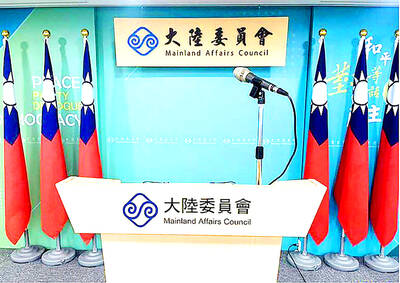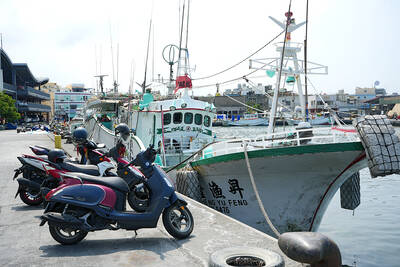A new outrigger canoe, a traditional mode of transportation for Austronesian people across the Pacific Ocean, has been built in Palau and is now on display in Taiwan at the National Museum of Prehistory in Taitung.
A ceremony was held at the museum yesterday to mark the completion of the seven-seat outrigger canoe.
In the ceremony, museum officials practiced a traditional Puyuma worship ritual while four shipbuilders from Palau practiced their traditional craft. Betel nuts, azure stones and hemp knitting were offered in the rituals as sacrifices.
According to the museum's deputy director, Tsuei Jui-ming (崔瑞明), the museum ordered a traditional outrigger canoe from Palau early this year to enrich its collections.
The shipbuilders were appointed in person by Palau President Tommy Remengesau, he said.
Widely used
Tsuei said that outrigger canoes have been used for thousands of years by the Austronesian people across the Pacific Ocean.
Taiwan's indigenous people are believed to belong to the Austronesian-language group, which probab-ly underwent the widest physical dispersion of a single language family -- prior to the European colonial expansion following Christopher Columbus -- from the island of Madagascar off the east coast of Africa all the way to Easter Island and extending to Taiwan, Vietnam, Northern Australia, New Zealand and most of the Melanesian and Polynesian islands.
Taiwan's indigenous people could have originated either from the southern part of China or from a vast Austronesian-language region.
Taiwan's Aborigines were considered the northernmost Austronesian people. The government divides them into 12 major mountain tribes and 10 Pingpu groups. While elements of the languages and culture of the 10 mountainous races have been maintained, most of the native languages of the Pingpu people have died out and no traces remain.
Among the mountainous Aborigines, the Saisiat and the Atayal are believed to have migrated to Taiwan some 3,000 years ago.
Anthropologists have no idea what exactly happened, or when, to cause some of Taiwan's earliest natives to die out or disappear, but efforts to seek traces of the original natives' existence via anthropological, linguistic and historical studies are continuing.
Theories
In a relatively newer theory developed in Australia and New Zealand in recent years, anthropologists believe that Taiwan is the place where the Austronesian-language people originated from.
Geoffrey Chambers of Victoria University in Wellington believes that Maori people and other Polynesian peoples of the Pacific "island-hopped" from Taiwan through the Philippines and Indonesia to West Polynesia. From there, he says, they traveled to the islands of East Polynesia and then south-west, eventually settling in New Zealand.

ENTERTAINERS IN CHINA: Taiwanese generally back the government being firm on infiltration and ‘united front’ work,’ the Asia-Pacific Elite Interchange Association said Most people support the government probing Taiwanese entertainers for allegedly “amplifying” the Chinese Communist Party’s propaganda, a survey conducted by the Asia-Pacific Elite Interchange Association showed on Friday. Public support stood at 56.4 percent for action by the Mainland Affairs Council and the Ministry of Culture to enhance scrutiny on Taiwanese performers and artists who have developed careers in China while allegedly adhering to the narrative of Beijing’s propaganda that denigrates or harms Taiwanese sovereignty, the poll showed. Thirty-three percent did not support the action, it showed. The poll showed that 51.5 percent of respondents supported the government’s investigation into Taiwanese who have

South Korean K-pop girl group Blackpink are to make Kaohsiung the first stop on their Asia tour when they perform at Kaohsiung National Stadium on Oct. 18 and 19, the event organizer said yesterday. The upcoming performances will also make Blackpink the first girl group ever to perform twice at the stadium. It will be the group’s third visit to Taiwan to stage a concert. The last time Blackpink held a concert in the city was in March 2023. Their first concert in Taiwan was on March 3, 2019, at NTSU Arena (Linkou Arena). The group’s 2022-2023 “Born Pink” tour set a

A Philippine official has denied allegations of mistreatment of crew members during Philippine authorities’ boarding of a Taiwanese fishing vessel on Monday. Philippine Bureau of Fisheries and Aquatic Resources (BFAR) spokesman Nazario Briguera on Friday said that BFAR law enforcement officers “observed the proper boarding protocols” when they boarded the Taiwanese vessel Sheng Yu Feng (昇漁豐號) and towed it to Basco Port in the Philippines. Briguera’s comments came a day after the Taiwanese captain of the Sheng Yu Feng, Chen Tsung-tun (陳宗頓), held a news conference in Pingtung County and accused the Philippine authorities of mistreatment during the boarding of

88.2 PERCENT INCREASE: The variants driving the current outbreak are not causing more severe symptoms, but are ‘more contagious’ than previous variants, an expert said Number of COVID-19 cases in the nation is surging, with the Centers for Disease Control (CDC) describing the ongoing wave of infections as “rapid and intense,” and projecting that the outbreak would continue through the end of July. A total of 19,097 outpatient and emergency visits related to COVID-19 were reported from May 11 to Saturday last week, an 88.2 percent increase from the previous week’s 10,149 visits, CDC data showed. The nearly 90 percent surge in case numbers also marks the sixth consecutive weekly increase, although the total remains below the 23,778 recorded during the same period last year,